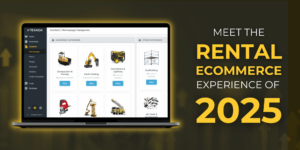Technology adoption is key to the scalability of an equipment rental business. Learn more about how business leaders are meeting the challenge with key strategies for success.
For many equipment rental businesses, technology adoption is becoming overwhelmingly critical to their success. With customers requesting more capabilities, expanded services, and a streamlined user experience, rental houses have been challenged to provide more resources and update their systems to stay competitive.
“The customer has a different expectation now than they did in 2019,” said Josh Nickell, Vice President of the Equipment Segment at the American Rental Association (ARA). “There are so many contractors who were laying in bed at night at the end of 2020 and realized they forgot equipment for the job the following morning. They quickly learned that the ability to perform simple tasks like reserving equipment on their phone without having to call a sales rep was really convenient.”
Organizations that embraced their digital transformation have reaped the rewards, while others, many of which still rely on paper-based systems, have struggled to meet the needs of an evolving market.
Reliance on Rental
With reliance on rental equipment showing no sign of decreasing, organizations need to be prepared to continue to scale their services. As Nickell shares in a recent survey, nearly half of contractors plan to boost their rental budget in the next twelve months.
“We surveyed contractors at the end of last year, and there’s some amazing news – 99 percent of contractors expect to rent in the next 12 months,” he said. “Additionally, 45 percent planned to increase their reliance on rental in the next year, 42 percent planned to stay the same, and only 3 percent planned to decrease their reliance on rental. The responses showed that contractors depend on rental, and they’re increasing their reliance.”
With increased business opportunities, rental houses will need to do more with less.
“I think it’s really important to be investing in your rental equipment technology, especially your customer-facing technology,” said Adam Kropf, Head of Product Management at Texada Software. “But we could also talk about why we need technology to deal with the equipment scarcity and the skilled labor shortage, too.”
By leveraging software solutions, many equipment rental businesses report nearly unbelievable benefits to efficiency, something Nickell has seen firsthand.
“There’s a lot of waste in the equipment rental industry, at least there is historically,” he said. “We’ve got to be able to move faster and be more efficient. We need to automate some of these processes. Having worked in rental software and been a user myself, I know that most rental companies probably don’t use half of the features available to them,” he said. “One of my first recommendations is always to call your rental software provider and hire them to come out to you in person. I learned the power of digitization firsthand. I was really slow to adopt digitizing my parts ordering process. When I saw the results, I was embarrassed. The return on investment was insane. The published return on investment was 1,000 percent.”
For those in doubt, Nickell offers another sobering statistic that can be directly measured.
“One of the most critical statistics that should motivate somebody to think about the return on investment of this kind of technology is that we had an 85 percent reduction in staff time per service,” he said.
According to Nickell, what was originally a 60-minute average service time, was reduced to only six. Some of the many steps in the process included:
- Identifying the need
- Locating the parts manual
- Logging into the system
- Completing the order and paying for the part
- Potential additional approvals
With this one example, a case can easily be made for streamlining additional processes that make up the day-to-day operations for equipment rental businesses.
“Our average part ordering process went from 60 minutes to 6 minutes by digitizing the process,” said Nickell. “We are talking about mechanic time. It’s incredibly hard to find more mechanics. There just aren’t enough to satisfy the demand. Reducing mechanic time from 60 to 6 minutes, it’s amazing and allows your scarce labor to focus on more critical tasks. There are definitely many parts of the rental operations that can be improved through digitization like this example.”
Though technology adoption cannot solve all of the challenges encountered by today’s rental equipment teams, saving time and easing the strain on the existing workforce, offering an improved customer experience, and boosting productivity can help businesses to be more successful.
Technology Adoption Strategies
Customers demand digital capabilities while businesses are challenged to do more with less, at scale.
Key strategies for technology adoption include:
- Streamlined digital experiences
- Professional web presence
- Online equipment rental capabilities
- Automated processes
- Efficiency improvements enabled by software solutions
- Improved use of existing resources (workforce, assets, etc)
With the right insight, strategies, and solutions, equipment rental organizations can more effectively leverage their own resources to accelerate business success.
To learn more about these strategies and how your rental business can navigate the skilled labor scarcity, rapid technology adoption, and equipment shortages, download the full Rental Report from Texada Software today.



 December 13, 2024
December 13, 2024 3 minutes read
3 minutes read
